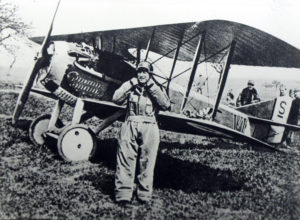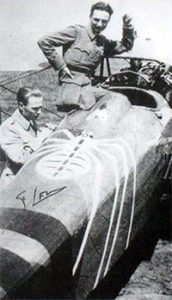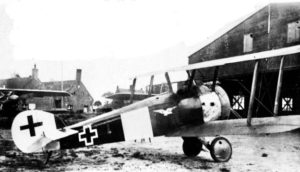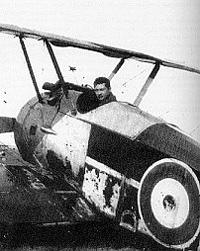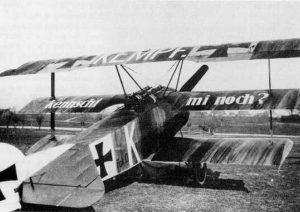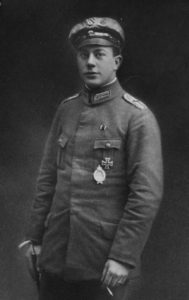The first series of airplane packs of WW1 Wings of Glory was recently reprinted and refreshed by new versions of each aircraft. The history and information about the SPAD XIII, Sopwith Camel, Albatros D.Va and Fokker Dr.I were already presented at the time they first released in specific articles, together with the pilots and units featured in each pack (see the links at the end of this article).
Now, let’s find out more about the aces who flew the new versions just released.
SPAD XIII – Fonck and Chavannes
The reprint of the SPAD XIII brings two new planes, piloted by René P. Fonck and Fernand Henri Chavannes, in addition to Eddie Rickenbacker, already featured in the first release.
René Fonck was the highest scoring ace for France and the Allies, with 75 victories, and the most successful fighter pilot to survive the war. When he was conscripted into the French Army in August 1914, he refused to serve in the Air Service, choosing instead to go to the trenches. He changed his mind six months later and began his flight training. He first served with Escadrille C47, flying reconnaissance missions over the lines. He claimed his first 'kill' (a German aircraft on the Western Front) on 6 August 1916, still at C47. In April 1917, Fonck was assigned to Spa 103. Flying the SPAD VII, he developed a reputation for studying the tactics of his opponents and conserving ammunition during a dogfight. On two separate occasions, he shot down six enemy aircraft in one day.
After the end of the war, Fonck worked as a racing and demonstration pilot. From 1937-39 he acted as Inspector of fighter aviation within the French Air Force. His inter-war contact with the likes of former World War I foe Hermann Göring and Ernst Udet cast a shadow upon Fonck's reputation during the German occupation of France and led to allegations of collaboration with the Nazi occupying forces and the Vichy regime. After the war, a French police inquiry about his supposed collaboration with the Vichy regime completely cleared Fonck. He died in 1953.
Sous Lieutenant Fernand Henri Chavannes was born in an upper-middle class family with a father who was a world famous academic and professor. He spent time in boarding school in Germany before the war and learned the language well enough to be a scholar in it, returning to France to complete his studies and planning on a career in physics.
But the war interfered and, when his class was called up in 1916, he volunteered for the air service, first being made a driver (since that was a rare skill for the time). He became an aviation mechanic, took some private lessons, and then graduated as a flying corporal in April 1917. He began to fly in Nieuports but soon switched to SPADs and was promoted Sergeant in June. After transferring to the Belfort area in January1918, he scored his first victory in February over a German fighter. He followed with 4 kills over 2-seaters in March and transferred to another unit, along with his friend and constant flying companion Lionel de Marmier, who he shared the use of a SPAD XII with, such that each man’s last initial was incorporated into the marking. Chavannes was not very fond of the plane, feeling that it was too dangerous to reload.
Chavannes said he preferred flying the SPAD VII to the XIII for its lighter handling, but he used both through the end of the war, shooting down two Fokker D-VIIs in July and August. He ended the war with a new unit that did not engage in combat and lived until 1985.
Sopwith Camel – Kissenberth and McLaren
Otto Kissenberth was born in 1893 in Bavaria and became a mechanical engineer, working for the Gustav Otto aircraft company before the war. He joined the German Air Force in 1914 and completed his training as a reconnaissance pilot late that year. He served in the Alsace region, was wounded, sent to Italy after he recovered, then came back to the Vosges area as one of the fighter pilots with KEK Einsisheim, gaining his first three victories in October 1916.
Retrained and joining Jasta 16, he gained three more victories in July 1917 and then took command of Jasta 23. He was one of several German aces who wore glasses during the war, as this was not considered a disqualification. He is known to modelers for the plane he flew -most often a black Albatros D.V with yellow and white Edelweiss painted on its fuselage (harkening to his Bavarian mountain home). He gained 12 more victories in 1917, almost entirely against the French.
After an extended leave he returned for another victory in January 1918, and then acquired a captured Sopwith Camel, which he repainted in German markings. He scored his final victory (of 20) in May over a Se5, possibly being able to approach very closely because of the ‘friendly’ outline of the Camel. But less than 2 weeks later, he was severely injured crashing the Camel. Some reports suggested engine failure (by this time the castor oil substitute the Germans were using was very hard on rotary engines) or possibly due to the dangers of the Camel, which killed more ALLIED pilots in accidents than any other plane. Though he survived, his injuries were so severe he never flew again, finishing the war commanding a flying school. Kissenberth died in a mountain climbing accident in 1919, in his beloved Bavarian Alps.
Donald Roderick MacLaren was one of the most successful (and fast-scoring) pilots of WW1, and noteworthy for gaining all of his victories while flying a single airplane type - the Sopwith Camel. And also noteworthy for a bizarre end to his war career.
Born in Ottawa, he joined the war effort in 1916, enlisting in the RFC. After extensive training, he joined #46 Squadron in late November 1917. His first victory came in February 1918, when he was credited with a German fighter “out of control” (OOC). He is credited with a total of 54 victories in only nine months of action, although the situation is somewhat clouded in that many are “shared” victories and others the nebulous “OOC,” with some of those also being “shared.” Still, his career was remarkably successful and injury free - until late October 1918, when he broke his leg during a friendly wrestling match at the squadron. He was in hospital when the Armistice came.
Spending his entire flying career in #46, one of his most remarkable days was early, March 21, when he was part of a bomber raid to knock out a German rail gun and was also involved in shooting down three planes and a balloon, for which he was awarded the Military Cross. With the German 1918 offensive going on, his unit was involved in heavy air actions through the spring and early summer, which aided his quick scoring. He took command of #46 in September 1918, serving until his injury.
After the War, he took command of the newly formed RCAF and helped organize it, resigning in 1920 and forming Pacific Airways and later became a high officer in Trans-Canada Airlines (which we now know as “Air Canada.”). He died aged 95 in 1988.
MacLaren served in #46 with Y.M.Yeats, the author of the novel “Winged Victory.” In that book, the squadron commander was called “Mac,” and is believed based on MacLaren. How could it be otherwise?
Albatros D.Va – Weber and Manfred von Richthofen
Born in 1895, in Freiburg, Ludwig Weber was a pilot and designer of cars, motorcycles and aircraft. During the World War 1, he was a fighter pilot of Jasta 3 from November 1916, flying the Albatros D.V, until November 1917, when he was shot down over northern France. Following, he served as a flight instructor in the Jagdstaffelschule I for a short time and then was assigned to the Kampfeinsitzerstaffel 4b (Kest 4b), used as Homeland Security Squadron in Freiburg im Breisgau, where he was at the end of the war.
After the war he worked in the production of cars and motorcycle in Freiburg, and was engaged in various posts in aviation in Germany, Ethiopia, Portugal and Brazil: engineer and pilot at Junkers, personal pilot of Emperor Haile Selassie and aircraft designer in Ethiopia, flight instructor of Portuguese air force, and head of VASP – Viação Aérea São Paulo, where he ended his pilot career in 1949. Back to Europe, he lived in Switzerland and died in 1991.
Manfred von Richthofen bio was already posted in the article dedicated to the Albatros D.III.
Fokker Dr.I – Kempf and Bäumer
Frederich "Fritz" Kempf was born in May 1894 in Freiburg, Baden. He interrupted his engineering studies to fulfill his Einjahrfreiwilliger compulsory military obligation and at age 19, he joined infantry in October 1913. His volunteer service was extended by outbreak of the war. He was promoted to Unteroffizier in August 1914 as his unit prepared to go to battle. In the Battle of the Frontiers which seesawed back and forth around Muelhausen, Upper Alsace, Kempf was seriously wounded and remained in the hospital until February 1915.
During the healing process he applied for a transfer to the Luftstreitkraefte arriving at FEA 3 in Gotha on May 6, 1915. He was then sent back to Freiburg to complete training and then on to FEA 9 at Darmstadt at the end of November 1915. In January 1916, at Kampfstaffel 20 of Kampfgeschwader 4, he fought on the Somme and at Verdun. With Halbgeschwader I he fought in Romania and Macedonia, then returned to the Western Front in February 1917. On March 20th, 1917, he received the Iron Cross 1st Class and joined Jasta 2 "Boelcke". He shot down a BE2d on 30th April, a Sopwith Pup on 5th May, a Sopwith Camel on 20th October and, after a period at Jastaschule I, another Sopwith Camel on 8th May 1918. He returned to Jastaschule I where he served until the end of the war. With 4 victories, he never became an ace. He died in August 1966.
Paul Bäumer was born in the northern Rhine area of Germany in 1896 and was working at a dental assistant when the war began. Even though he had achieved a private pilot’s license before hostilities began, he started the war in an infantry regiment, serving first in France and then in Russia, where he was wounded. While recovering he transferred to the air service and was accepted—as a dental assistant! Finally achieving his military pilot’s certificate, he began his flying career as a ‘ferry’ pilot and instructor, before finally getting single-seat training in 1917, and was assigned to Jasta 5 in June of that year. He scored three victories (over balloons!) before being transferred to the elite Jasta Boelcke, where his total reached 18 victories by the end of 1917, all while an NCO pilot and receiving the Golden Military Merit Cross (the highest award for non-officers).
Bäumer was promoted Leutnant in April 1918, but he was badly injured in a crash in May 1918. He did not return to flying duty until September, but achieved 21 victories in the short remaining span of the war, flying the Fokker D.VII. His career would have been cut short in September, when his plane was shot into flames, but he saved himself with a parachute. He finished the war with 43 victories and received the Blue Max shortly before the Armistice, one of the few soldiers to get both highest decorations.
After the war, Bäumer worked in the dockyards before becoming a dentist. If someone recognizes his name as the lead character in the book “All Quiet on the Western Front,” it could be because the author, E. M. Remarque, was one of Bäumer’s dental patients! He died in 1927, stunt flying a new airplane in Denmark, having set records for both speed and altitude.
SPAD X.III – Part 1, Part 2
Sopwith Camel – Part 1, Part 2
Albatros D.Va – Part 1, Part 2
Fokker Dr.I – Part 1, Part 2
Information sources: The Aerodrome; The Canadian Encyclopedia; The Great War - FirstWorldWar.com; Ciel de Gloire; Vintage Aviation; French aces of the Great War; Donald Roderick MacLaren - a Short History; PPRuNe Forums; As 14 - 18; Frontflieger; Wikipedia; "Above the Lines: The Aces and Fighter Units of the German Air Service, Naval Air Service and Flanders Marine Corps, 1914–1918", Franks N., Bailey F., Guest R.(Grub Street, 1993); "Early German Aces of World War I", VanWyngarden G. (Osprey Publishing, 2006); "Jasta Boelcke: The History of Jasta 2, 1916-1918", Franks N. (Grub Street, 2004); "German Knights of the Air 1914-1918: The Holders of the Orden Pour le Mérite. New York", Treadwell T. and Wood A. (Barnes & Noble Books, 1998); "The Decatur Review" (Decatur, Illinois, July 16, 1927); "Above the War Fronts", Franks N., Guest R., Alegi G. (Grub Street, September 1997); "Air Aces of the Austro-Hungarian Empire 1914-1918", O'Connor M. (Flying Machines Press, January 1986); "Austro-Hungarian Aces of World War 1", Chant C., Rolfe M. (Osprey Publishing, 2002); "Over The Front. A Complete Record of the Fighter Aces and Units of The United States and French Air Services, 1914-1918", Franks N. and Bailey F. (Grub Street, 1992).


